Recent Articles
Popular Makes
Body Types
2019 Toyota Highlander Hybrid Road Test and Review
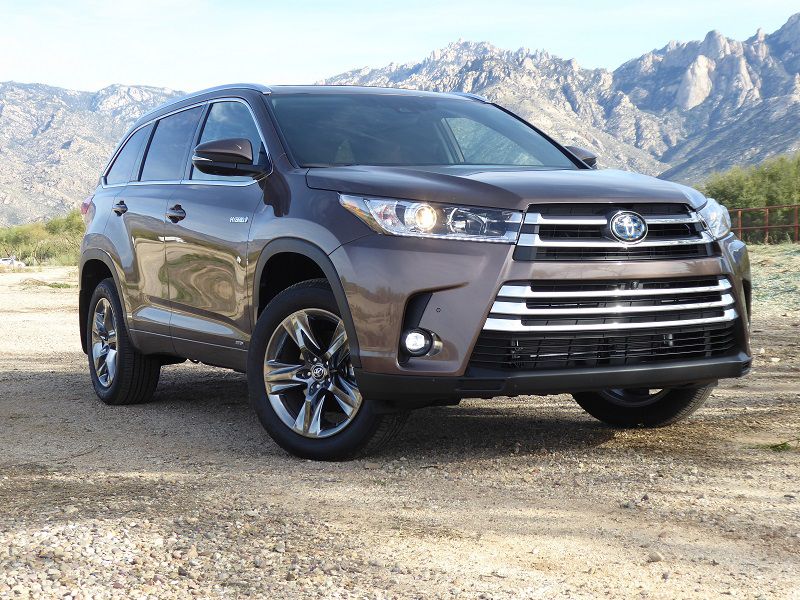
2019 Toyota Highlander Hybrid Brown Front Three Quarter RS ・ Photo by Ron Sessions
The 2019 Toyota Highlander is a big player in the three-row midsize crossover SUV market. Last year it beat all competitors in sales, except for the Ford Explorer. It’s also the second-best-selling crossover in Toyota’s lineup, right behind the compact RAV4, which was the top-selling SUV in the U.S. in 2018.
While the Highlander doesn’t outdo the Toyota Sequoia for total interior space, the Land Cruiser for sheer toughness, or the RAV4 for fuel economy, this mid-size SUV offers a blend of passenger and cargo space, carlike ride and handling, and a wide selection of amenities that appeal to a broad range of buyers. As with most Toyota passenger cars and crossover SUVs, the Highlander — now in its third generation — is offered with a conventional gasoline powerplant or gas-electric hybrid. The hybrid's prices start at $38,015.
Hybrid in the Hood
Aside from oil changes and other routine maintenance, this view under the hood is one many Highlander buyers will rarely see. The Highlander Hybrid is equipped with a 231-horsepower 3.5-liter V6 and two electric drive motors for a total system output of 306 horsepower, with plenty of power for merging and passing. Working through an electronically controlled continuously variable transmission, the gasoline and electric propulsion source blend seamlessly for maximum efficiency. There is no electric charger to plug in; instead, the gas engine keeps the 45-kW nickel metal hydride hybrid battery sufficiently charged to help propel the vehicle.
Toyota’s legendary reliability and the company’s extensive experience with hybrid technology (Toyota offers seven different gas-electric hybrid models in its 2019 lineup) rank as big factors in selecting a hybrid over a conventional gas-powered Highlander. Another consideration, obviously, is fuel economy. Depending on the trim level, the 2019 Highlander Hybrid is EPA-rated at 29 to 30 mpg in the city, 27 to 28 mpg on the highway, and 28 to 29 mpg combined. That's about 10 mpg better in city driving and 6 mpg overall than a comparable non-hybrid Highlander.
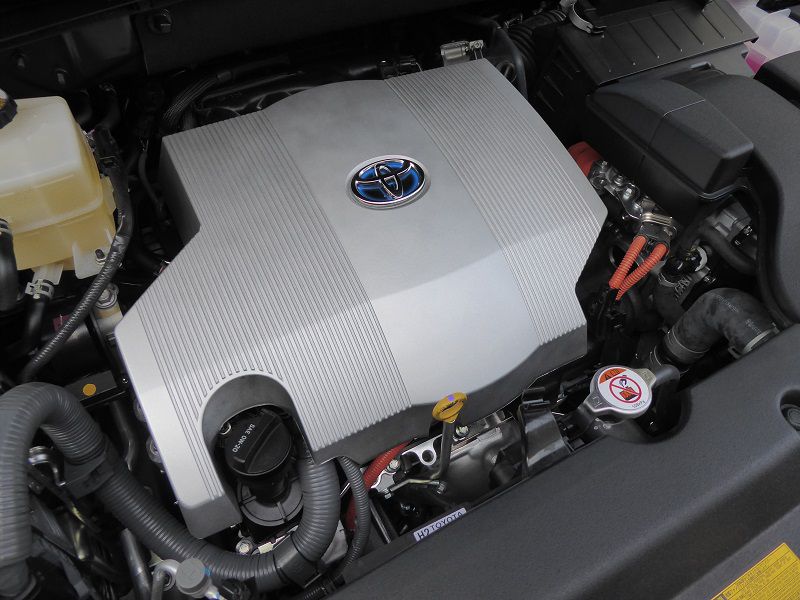
Photo by Ron Sessions
Standard All-Wheel Drive
The 2019 Toyota Highlander Hybrid is available in four trims, ranging from the high-$30,000s to just under $50K. Including the $1,045 destination and handling charge, the lineup includes the base $38,015 LE, $43,075 XLE, $46,555 Limited, and range-topping $49,675 Limited Platinum.
Buy any Highlander Hybrid trim and Toyota throws in all-wheel drive for free. It’s called AWD-i, or all-wheel drive with intelligence. There are two electric drive motors, one each at the front and rear axles. The rear motor comes into play to drive the rear wheels only when needed to maintain traction. There is nothing the driver has to do to activate the AWD system — it is automatic.
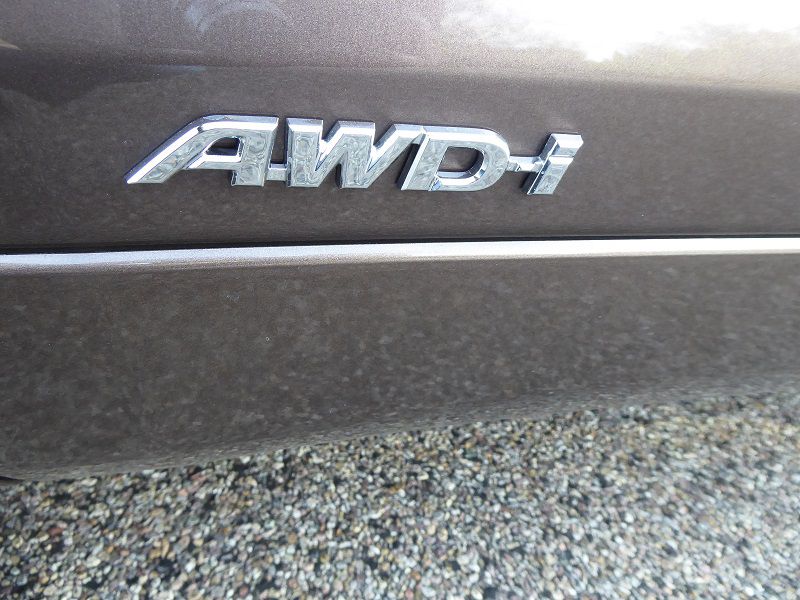
Photo by Ron Sessions
Take Your Seats
As you might expect of a mid-size family hauler, the Highlander Hybrid is roomy with easy ingress/egress and easy-to-operate controls. Cloth seats are standard on the base LE, with leather-covered first- and second-row chairs on the XLE and above. The driver's seat in upper trims is power-operated with adjustable lumbar and thigh support, and the Limited model brings heated and ventilated perforated leather front buckets. The seats are firm and supportive but comfortable for a wide range of body types. Seating is elevated a bit, but not so much that most people will need running boards to get in and out.
A conventional Optitron analog speedometer and hybrid system meter (with power, eco, and charging zones) frame a 4.2-inch multi-information display. XLE and higher models get three-zone automatic climate control. Push-button start with keyless front door entry is standard. A cool feature on the XLE and above is Driver Easy Speak, which enables the driver to directly address naughty rear-seat occupants via the rear audio speakers.
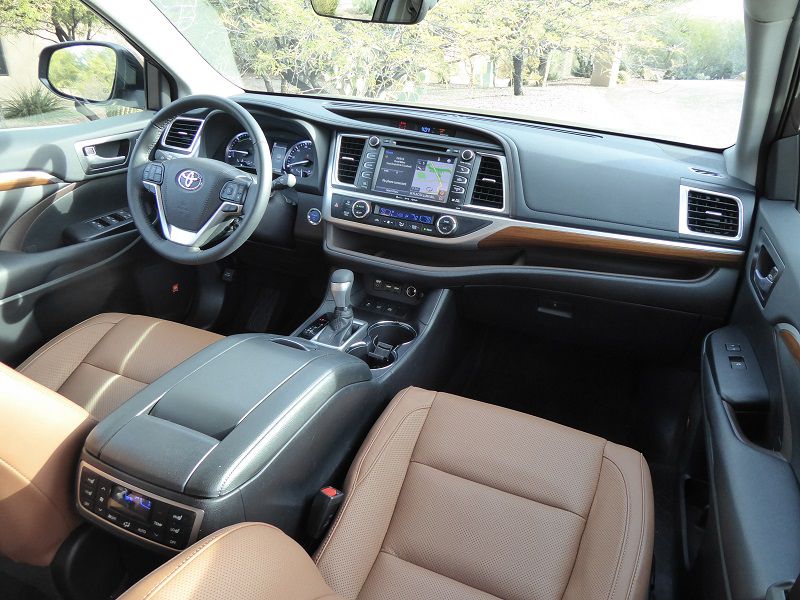
Photo by Ron Sessions
All About the Ambiance
The Highlander Hybrid provides plenty of stowage spaces for life’s detritus. This includes generous bins in the doors, a huge, tablet-sized 24.5-liter bin under the center console armrest and a handy shelf with a non-slip surface that runs under the dash all the way from the center stack to the passenger door.
On Limited and higher models, this shelf — as well as elements of the dash, console, and door trim — are bathed in a soothing blue hue of ambient lighting that's visible when driving at night. The Limited Platinum also adds a large panoramic moonroof to the mix.

Photo by Ron Sessions
Zoomy Tunes
The base Highlander Hybrid LE gets by with a smallish 6.1-inch touchscreen for its six-speaker AM/FM/CD/MP3/WMA stereo with voice control, Siri Eyes Free and Bluetooth connectivity. But the XLE and higher models get this Entune Premium Audio system with split-screen-capable 8-inch hi-res touchscreen, App Suite, traffic and weather updates, SiriusXM, and HD radio.
Traditional rotary volume and tuning knobs, as well as quick key buttons flanking the 8-inch screen, make simple adjustments and selections easy. On the Limited and above, an upgraded JBL stereo brings 12 speakers for an immersive sound. However, in-car 4G Wi-Fi, Apple CarPlay, and Android Auto connectivity are not yet available.
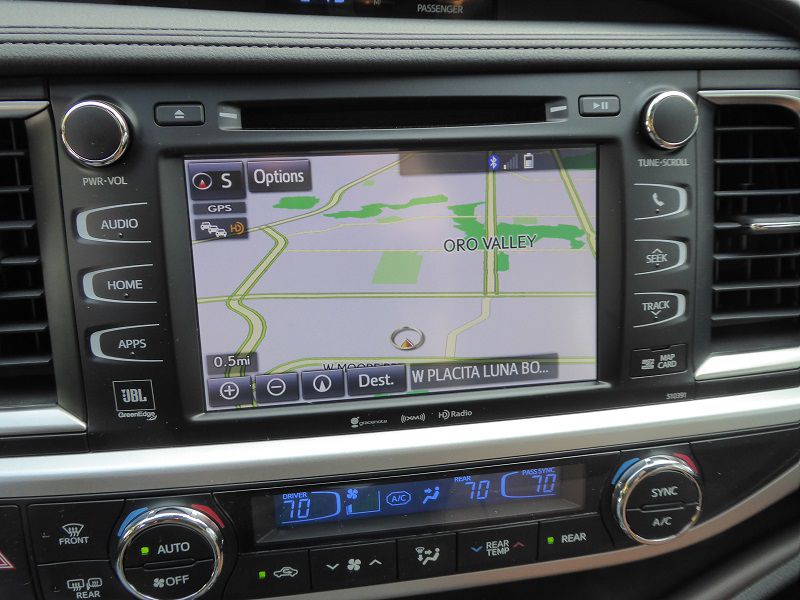
Photo by Ron Sessions
Second-Row Accommodations
The Highlander Hybrid’s second row is just about as comfortable and roomy as the front-seat space. On LE and XLE models with eight-passenger seating, this includes a reclining and fold-flat three-across bench seat that also slides fore and aft to apportion third-row legroom or cargo space as needed. On XLE and higher models, the second row gets its own temperature control panel and air vents.
Limited and Limited Platinum Highlanders with the seven-passenger seating shown here feature a pair of sliding, reclining, and fold-flat captain’s chairs. They include adjustable armrests and a center tray with cupholders that folds down to enable access to the third row from between the two seats. On XLE and higher models, there are also folding sunscreens for the rear windows that can be retracted into the doors when not in use.
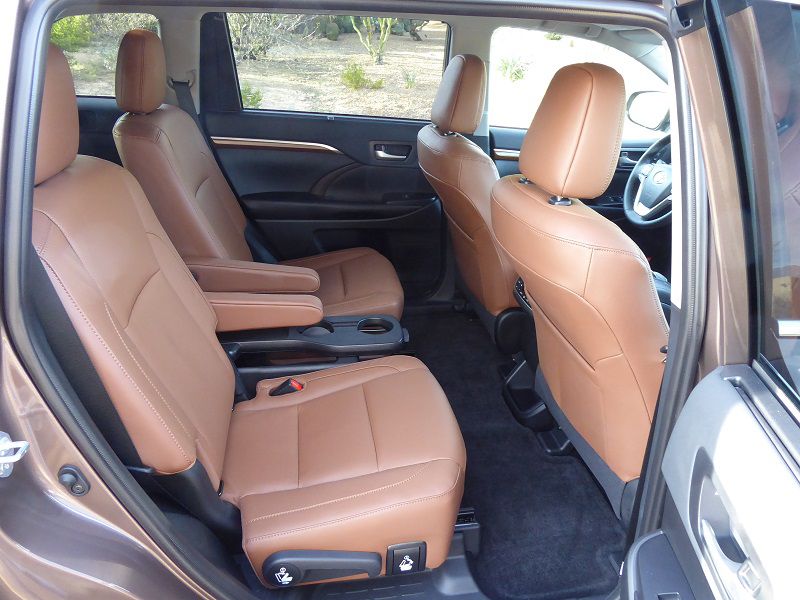
Photo by Ron Sessions
Third-Row Accommodations
There are three pairs of seatbelts back there, but the third row is really only suitable for kids. The second-row seats slide forward to ease access to the aft quarters, but any adults who do make the trek back there won’t want to stay for long. The bottom cushions are nearly on the floor, headroom is 2 to 3 inches less than in the second row, and third-row legroom is a foot shy of that available one row forward.
To improve rearward visibility, the third-row headrests can be lowered nearly flush with the third-row seatbacks. On all Highlander models, the third-row seats are split 60/40, recline, and are covered in SofTex faux leather.
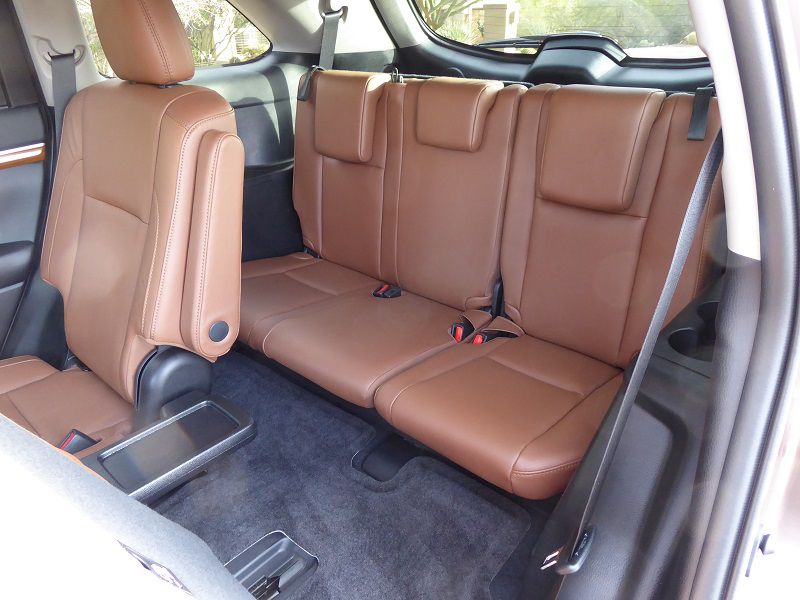
Photo by Ron Sessions
Cargo Kingdom
Ikea runs were made for bigger SUVs, and here the Highlander Hybrid definitely does not disappoint. By the numbers, there’s 13.8 cubic feet of cargo space behind the third-row seat, 42.3 aft of the second row, and 83.7 home-improvement-swallowing cubic feet of space to the rear of the front buckets.
Just to put that in perspective, the test Highlander swallowed these two near-7-foot-long shelving units plus some other boxes with the front passenger seat moved up just a titch. The rear hatch closed just fine, and it's is power-operated and adjustable for opening height on XLE and higher models. The hatchback glass window also opens separately from the hatch if desired, a Toyota-exclusive feature among mid-size crossovers. About the only option missing is a hands-free, foot-wave-under-the-rear-bumper hatch-opening feature.

Photo by Ron Sessions
Safety Sensible
The Highlander Hybrid makes sense for buyers looking for a roomy, comfortable, nearly-full-size SUV that drives more like a car than a truck and is capable of achieving some pretty impressive fuel economy. It takes some time to get accustomed to the hybrid’s unconventional brake pedal feel, which attempts to blend mechanical and regenerative braking, but there is no denying the positive results — I saw an indicated 29.6 mpg in a week of mixed suburban and highway driving.
In addition to a host of airbags and a standard backup camera, all Highlander Hybrids are equipped with Toyota’s Safety Sense P suite of technologies that includes automatic emergency braking, adaptive radar cruise control, automatic high beams, and a lane-departure alert with steering assist. XLE and higher models add blind-spot and rear cross-traffic monitoring, and the Limited Platinum brings front and rear sonar parking assist.
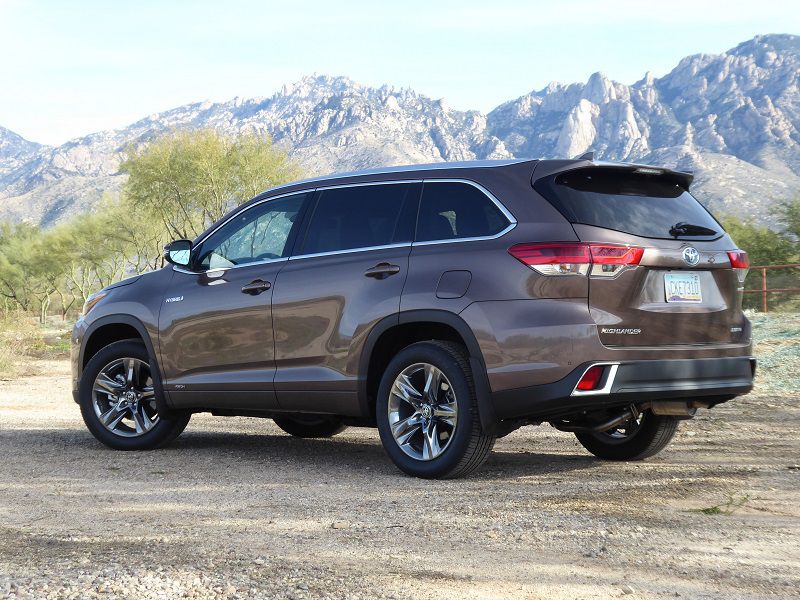
Photo by Ron Sessions